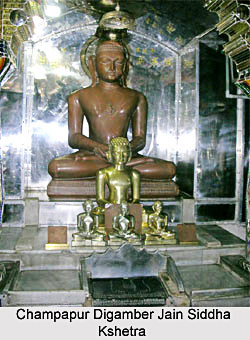 Champapur Digamber Jain Siddha Kshetra is a popular Jain pilgrimage place. It is located in the village Nathnagar in Bhagalpur District in Bihar. It is a Siddha Kshetra i.e. a place of Salvation. This Jain Siddha Kshetra is quite an ancient and historic Teerth place. Champapur is the only `Panch Kalyanaka Kshetra` in the world.
Champapur Digamber Jain Siddha Kshetra is a popular Jain pilgrimage place. It is located in the village Nathnagar in Bhagalpur District in Bihar. It is a Siddha Kshetra i.e. a place of Salvation. This Jain Siddha Kshetra is quite an ancient and historic Teerth place. Champapur is the only `Panch Kalyanaka Kshetra` in the world.
History of Champapur Digamber Jain Siddha Kshetra
Earlier Champapur served as the capital of `Anga Janpada`. There are 52 Janapadas established by the first Tirthankara Bhagwan Rishabh Dev and Anga Janapada was one of them. Among the six Maha Janapadas Champapur also existed as a Maha Janpada during the time of Lord Mahavira. Champapur has been famous for the three Chaturmasa period of Lord Mahavira during his Dikshakal, religious propagation centre of Anga-Banga-Magadh-Vaishali, test of modesty of Sati Subhadra and Anantmati, Aahardan to Lord Mahavira by Sati Chandan Bala. Champapur is also important as it was the `Samavsharan` of all 24 Jain Tirthankaras. Several stories like the origin of Harivansha, Shripal-Mainasundari, Shri Dharma Ghosh Muni, King Karna of Mahabharata, King Mudrak and great architect Vishvakarma` are also closely related to Champapur.
Temple of Champapur Digamber Jain Siddha Kshetra
The chief temple of Champapur Siddha Kshetra dates back to almost 2500 years. It is related to Panch Kalyanaka, (i) Garbha, (ii) Janma, (iii) Tapa, (iv) Gyan and (v) Moksha of 12th Tirthankara Lord Vasupujya Swami. An idol of 1008 Lord Vasupujya is installed here. The idol is reddish diamond in colour and is seated in a padmasana posture on the principal altar of main temple.
The temple has five altars, magnificent spire and two columns of fame. According to the history of the temple there were four `Columns of Fame (Keerti Stambha).` These were constructed in four corners of the campus of the temple. However, the earthquake in year 1934 destroyed two of the four Keerti Stambha. The rest two were repaired in 1938. The `Columns of Fame` are about 2200 years ancient. The entrance gate of the temple has been artistically decorated.
There are many idols installed in the temple. An idol of Lord Vasupujya Swami is established in centre of main altar. The idol is red in colour and is seated in padmasana posture. Another idol of Lord Vasupujya Swami present in the temple is made of `Ashtadhatu` (Alloy of eight metals). One can also see the ancient foot images of Lord Vasupujya in this altar. The temple also houses an `Ashta-Pratiharya` that has been created in an artful specimen of glass.
Apart from these there are Tonks that have been dedicated to the 24 Jain Tirthankaras. These Tonks have been built around a 61 feet high magnificent `Column of Dignity.` The first Tonk has been devoted to Lord Bahubali. It has been artistically designed and decorated. Foot images of `Ganadhar Mandar` can also be seen here Shri Mandar was the first Ganadhar of Lord Vasupujya. There are four Jin idols established respectively in four altars present in middle part of column. All the 16 dreams that have been dreamt by the respected mothers of the Jain Tirthankaras before conceiving a child have been intricately carved on marble around these four altars.
Apart from these there are temples of Lord Shantinath and Lord Mahavira constructed in the campus. The image of Shantinath is 9.25 feet in height while the image of Mahavira is 7.25 in height. The place also houses a beautiful temple dedicated to Lord Parshvanath. The `Khadagasan` idol is 7.25 feet in height and is surmounted by `7 Serpent Hoods.` There is also a `Samavsharan Mandir` which is dedicated to Bhagwan Simandhar. The temple is worth watching for its artistic beauty. On the southern side of the main temple an Adinath Jinalaya has been constructed. A Khadgasana idol of Lord Adinath dating back to Kushana Empire can also be seen here. The idol is believed to be more than 2000 years old.
A `Jal Mandir` is also constructed here that houses an idol of Lord Vasupujya. The idol is 16 feet high and is installed on a big lotus flower. The beautiful artificial lake is around the altar captures the attention of the visitors. The idol is surmounted by a huge umbrella of marble. Festivals are organised by the members of the community on the `Kalyanka` days of `Garbha, Janma, Tapa, Gyan and Moksha` like `Asharh Krishna, Falgun Krishna, Bhadrapada Krishna and Bhadrapada Shukla.




















